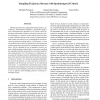Free Online Productivity Tools
i2Speak
i2Symbol
i2OCR
iTex2Img
iWeb2Print
iWeb2Shot
i2Type
iPdf2Split
iPdf2Merge
i2Bopomofo
i2Arabic
i2Style
i2Image
i2PDF
iLatex2Rtf
Sci2ools
SSDBM
2006
IEEE
2006
IEEE
Sampling Trajectory Streams with Spatiotemporal Criteria
Monitoring movement of high-dimensional points is essential for environmental databases, geospatial applications, and biodiversity informatics as it reveals crucial information about data evolution, provenance detection, pattern matching etc. Despite recent research interest on processing continuous queries in the context of spatiotemporal data streams, the main focus is on managing the current location of numerous moving objects. In this paper, we turn our attention onto a historical perspective of movement and examine trajectories generated by streaming positional updates. The key challenge is how to maintain a concise, yet quite reliable summary of each object’s movement, avoiding any superfluous details and saving in processing complexity and communication cost. We propose two single-pass approximation techniques based on sampling that take advantage of the spatial locality and temporal timeliness inherent in trajectory streams. As a means of reducing substantially the scale of...
Database | Numerous Moving Objects | Pattern Matching Etc | Single-pass Approximation Techniques | SSDBM 2006 |
| Added | 12 Jun 2010 |
| Updated | 12 Jun 2010 |
| Type | Conference |
| Year | 2006 |
| Where | SSDBM |
| Authors | Michalis Potamias, Kostas Patroumpas, Timos K. Sellis |
Comments (0)

